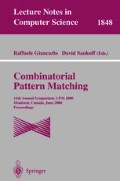Abstract
A widely-used method for determining the similarity of two labeled trees is to compute a maximum agreement subtree of the two trees. Previous work on this similarity measure only concerns with the comparison of labeled trees of two special kinds, namely, uniformly labeled trees (i.e., trees with all their nodes labeled by the same symbol) and evolutionary trees (i.e., leaf-labeled trees with distinct symbols for distinct leaves). This paper presents an algorithm for comparing trees that are labeled in an arbitrary manner. In addition to the generalization, our algorithm is faster than the previous algorithms in many cases.
Research supported in part by NSF Grant CCR-9531028
Research supported in part by Hong Kong RGC Grant HKU-7027/98E
Access this chapter
Tax calculation will be finalised at checkout
Purchases are for personal use only
Preview
Unable to display preview. Download preview PDF.
References
M. J. Chung. O(n 2.5) time algorithms for the subgraph homeomorphism problem on trees. Journal of Algorithms, 8:106–112, 1987.
R. Cole and R. Hariharan. An O(n log n) algorithm for the maximum agreement subtree problem for binary trees. In Proceedings of the 7th Annual ACM-SIAM Symposium on Discrete Algorithms, pages 323–332, 1996.
T. H. Cormen, C. L. Leiserson, and R. L. Rivest. Introduction to Algorithms. MIT Press, Cambridge, MA, 1991.
M. Farach, T. M. Przytycka, and M. Thorup. Computing the agreement of trees with bounded degrees. In P. Spirakis, editor, Lecture Notes in Computer Science 979: Proceedings of the 3rd Annual European Symposium on Algorithms, pages 381–393. Springer-Verlag, New York, NY, 1995.
M. Farach and M. Thorup. Sparse dynamic programming for evolutionary-tree comparison. SIAM Journal on Computing, 26:210–230, 1997.
C. R. Finden and A. D. Gordon. Obtaining common pruned trees. Journal of Classification, 2:255–276, 1985.
J. Friedman. Expressing logical formulas in natural languages. In J. Groenendijk, T. Janssen, and M. Stokhof, editors, Formal methods in the study of language, pages 113–130. Mathmatical Centre, Amsterdam, 1981.
H. N. Gabow and R. E. Tarjan. Faster scaling algorithms for network problems. SIAM Journal on Computing, 18:1013–1036, 1989.
A. Gupta and N. Nishimura. Finding largest subtrees and smallest supertrees. Algorithmica, 21(2): 183–210, 1998.
D. M. Hillis, C. Moritz, and B. K. Mable, editors. Molecular Systematics. Sinauer Associates, Sunderland, Ma, 2nd edition, 1996.
M. Y. Kao. Tree contractions and evolutionary trees. SIAM Journal on Computing, 27:1592–1616, 1998.
M. Y. Kao, T. W. Lam, W. K. Sung, and H. F. Ting. All-cavity maximum matchings. In Lecture Notes in Computer Science 1350: Proceedings of the 8th Annual International Symposium on Algorithms and Computation, pages 364–373, 1997.
M. Y. Kao, T. W. Lam, W. K. Sung, and H. F. Ting. A decomposition theorem for maximum weight bipartite matchings with applications to evolutionary trees. In Lecture Notes in Computer Science: Proceedings of the 8th Annual European Symposium on Algorithms, pages 438–449. Springer-Verlag, New York, NY, 1999.
P. Kilpeläinen and H. Mannila. Retrieval from hierarchical texts by partial patterns. In Proceedings of the 16th Annual International ACM-SIGIR Conference on Research and Development in Information Retrieval, pages 214–222, 1991.
P. Kilpeläinen and H. Mannila. Grammatical tree matching. In A. Apostolico, M. Crochemore, Z. Galil, and U. Manber, editors, Lecture Notes in Computer Science 644: Proceedings of the 3rd Annual Symposium on Combinatorial Pattern Matching, pages 162–174. Springer-Verlag, New York, NY, 1992.
B. Kimia, A. Tannenbaum, and S. W. Zucker. Shapes, shocks, and deformations, I. International Journal of Computer Vision, pages 189–224, 1995.
E. Kubicka, G. Kubicki, and F. McMorris. An algorithm to find agreement subtrees. Journal of Classification, 12:91–99, 1995.
S. Y. Le, J. Owens, R. Nussinov, J. H. Chen, B. Shapiro, and J. V. Maizel. RNA secondary structures: comparison and determination of frequently recurring substructures by consensus. Computer Application in Bioscience, 5:205–210, 1989.
H. Mannila and K. J. Räihä. On query languages for the p-string data model. In H. Kangassalo, S. Ohsuga, and H. Jaakkola, editors, Information Modelling and Knowledge Bases, pages 469–482. IOS Press, Amsterdam, 1990.
P. Materna, P. Sgall, and Z. Hajicova. Linguistic constructions in transparent intensional logic. Prague Bulletin on Mathematical Linguistics, pages 27–32, 1985.
T. Przytycka. Sparse dynamic programming for maximum agreement subtree problem. In B. Mirkin, F. R. McMorris, F. S. Roberts, and A. Rzhetsky, editors, Mathematical Hierarchies and Biology, DIMACS Series in Discrete Mathematics and Theoretical Computer Science, pages 249–264, Providence, RI, 1997. American Mathematical Society.
B. Shapiro and K. Zhang. Comparing multiple RNA secondary structures using tree comparisons. Compter Applications in Bioscience, pages 309–318, 1990.
F. Y. Shih. Object representation and recognition using mathematical morphology model. Journal of Systems Integration, pages 235–256, 1991.
F. Y. Shih and O. R. Mitchell. Threshold decomposition of grayscale morphology into binary morphology. IEEE Transactions on Pattern Analysis and Machine Intelligence, 11:31–42, 1989.
M. Steel and T. Warnow. Kaikoura tree theorems: Computing the maximum agreement subtree. Information Processing Letters, 48:77–82, 1993.
Y. Takahashi, Y. Satoh, H. Suzuki, and S. Sasaki. Recognition of largest common structural fragment among a variety of chemical structures. Analytical Science, pages 23–28, 1987.
Author information
Authors and Affiliations
Editor information
Editors and Affiliations
Rights and permissions
Copyright information
© 2000 Springer-Verlag Berlin Heidelberg
About this paper
Cite this paper
Kao, M.Y., Lam, T.W., Sung, W.K., Ting, H.F. (2000). A Faster and Unifying Algorithm for Comparing Trees. In: Giancarlo, R., Sankoff, D. (eds) Combinatorial Pattern Matching. CPM 2000. Lecture Notes in Computer Science, vol 1848. Springer, Berlin, Heidelberg. https://doi.org/10.1007/3-540-45123-4_13
Download citation
DOI: https://doi.org/10.1007/3-540-45123-4_13
Published:
Publisher Name: Springer, Berlin, Heidelberg
Print ISBN: 978-3-540-67633-1
Online ISBN: 978-3-540-45123-5
eBook Packages: Springer Book Archive

